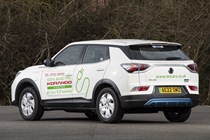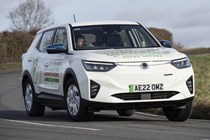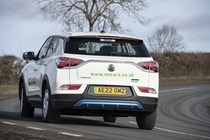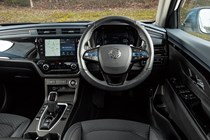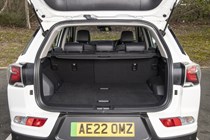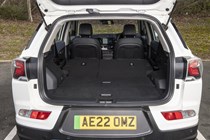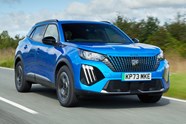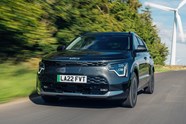
SsangYong Korando e-Motion (2022-2024) review
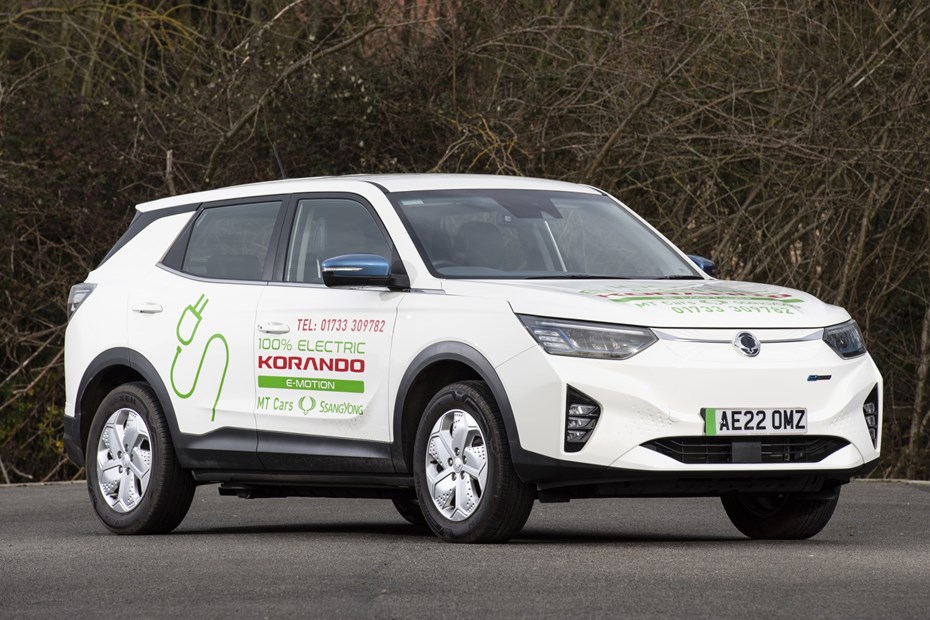
At a glance
| Price new | £31,995 - £37,995 |
|---|---|
| Used prices | £12,097 - £21,312 |
| Road tax cost | £0 |
| Insurance group | 31 - 32 |
Get an insurance quote with

|
|
| Fuel economy | 3.7 miles/kWh |
| Range | 211 miles |
| Miles per pound | 5.9 - 10.9 |
| View full specs for a specific version | |
Available fuel types
Fully electric
Pros & cons
- Spacious
- Seven-year warranty
- You can have one quickly
- Challenging looks
- Serious lack of front-end grip
- Rivals feel more plush
SsangYong Korando e-Motion (22-24) rivals
Overview
Every manufacturer needs an electric car in its lineup, but some take different approaches to others. While some manufacturers choose to build a new EV from the ground up, others instead opt to electrify one of their existing models – and that’s what SsangYong has done with the Korando e-Motion.
It’s a pure-electric version of the Korando, with a 61.5kWh battery and 188hp motor taking the place of a petrol or diesel engine. On paper, it looks good – if ungainly in the flesh – and one of the key appeals is lead time. While many manufacturers are supply-constrained with customers facing up to a year wait from ordering their car, our local SsangYong dealer told us we could have a car in as little as six weeks if we were to order today.
But would you be better off waiting longer for a more established electric SUV such as an MG ZS EV or Peugeot e-2008?
What’s it like inside?
The Korando e-Motion’s interior is solidly put together, and our test model had a pleasant blue finish which made a change from the usual monochrome cabins. There’s rather a lot of contrasting shiny plastic finishes, though, and there’s no denying that the materials used don’t feel as plush or as pleasant as those found in even a budget rival such as the MG ZS EV. Compared to an e-2008, there’s no contest.
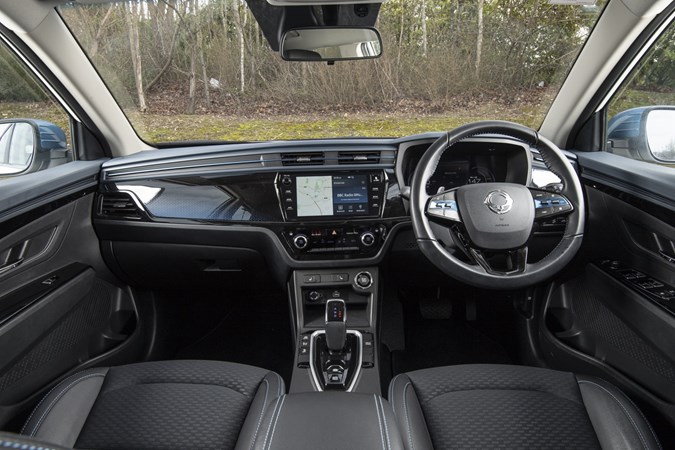
Set fairly high on the dash, in a good location, is the infotainment system’s screen (8.0 inches on entry-level cars, 9.2 inches on all others) while beneath that is a physical climate control panel. We always like seeing these, as they’re easier to adjust on the move than fiddling with a touchscreen.
There’s no denying that the graphics, both on the touchscreen and the digital gauge cluster, feel old-fashioned, and there’s rather a glut of useless features – who wants to be able to choose between six different soundfonts?
In practicality terms, the Korando is pretty spacious. The rear seats offer enough leg- and head-room for a six-foot passenger to sit behind a similarly-sized driver with a little wiggle room. The boot, meanwhile, is very large indeed, with a wide tailgate and no load lip when the adjustable floor is raised. You get plenty of room beneath that floor for storing the charging cables, too, and there’s even a spare wheel.
Comfort
Driver and passenger comfort varies depending on specification. All models have plenty of space, of course, and refinement is perfectly acceptable with wind and road noise not made too obvious by the lack of an engine note.
However, the driver’s seat doesn’t have many dimensions of adjustment, and you don’t get adjustable lumbar support until you reach the top trim level. It does at least move a long way, and two-way adjustment on the wheel means drivers of all sizes should find a comfortable position.
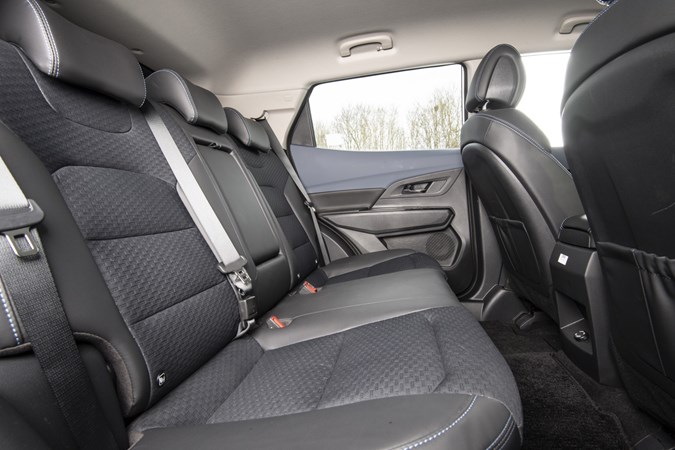
The front seats are heated from the mid grade, and on the top trim level they gain ventilation as well as heating for the rear seats. Top-spec cars also get a heated steering wheel and full leather upholstery, though honestly we prefer the additional warmth of cloth.
Rear passengers might not enjoy the rear seats, which are very upright and could get uncomfortable on a long trip.
Safety
Not much to be concerned about here from an official perspective – the Korando (though not specifically this electric version) was tested by Euro NCAP in 2019 and scored a full five stars.
Every Korando e-Motion comes with SsangYong’s full glut of safety features, including adaptive cruise control, autonomous emergency braking, lane-keeping aids, blind-spot monitoring, a driver attention alert, speed limit warnings and an artificial sound to alert pedestrians when the car’s travelling slowly.
It also has Isofix points in the two outer rear seats to enable safe and easy mounting of child seats.
We’re not entirely convinced of its driving safety, though more on that in the next section…
What’s it like to drive?
Anyone used to SsangYongs will find the performance of the Korando e-Motion a bit disarming. By electric car standards, it’s not hugely rapid – 0-62mph takes more than nine seconds – but that’s more than quick enough, and it’s very rapid in the 0-30mph range you’ll be operating in round town.
You can select more or less regenerative braking via the paddles on the steering wheel, though even at its highest setting the regen won’t bring you down to a full stop.
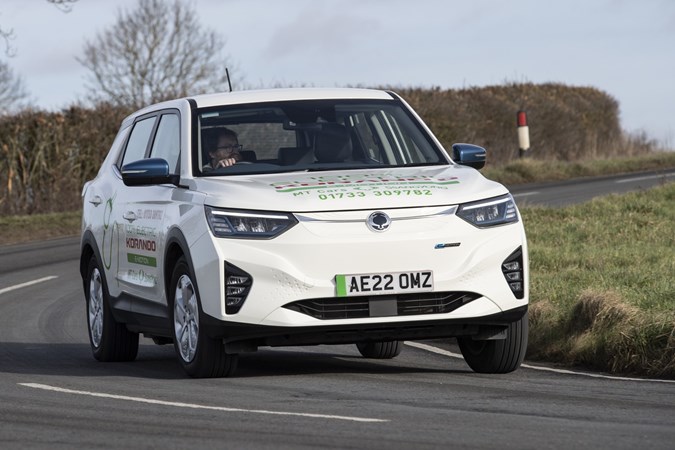
Where the Korando comes apart is in the corners, where it suffers a chronic lack of grip. Much of that could be put down to the tyres our test vehicle was on – we’d certainly insist these were changed before we purchased the vehicle.
A little understeer in a fast corner is one thing, but washing uncontrollably wide while doing 15mph around a roundabout is dangerous, and it left us with very little confidence in the Korando e-Motion, tip-toeing around every corner as if we might end up in the verge.
When you’re not panicking about the front-end grip, the Korando rides acceptably well, filtering out most sharp imperfections. The steering isn’t particularly precise, but it’s nice and light for town driving.
Ownership costs and maintenance
Keeping your Korando should be a cost-effective experience. Not only is it fairly efficient with its battery, lowering charging costs, but SsangYong offers a generous seven-year warranty, 90,000 mile warranty – though slightly shy of Kia’s seven-year, 100,000-mile coverage on the Niro EV.
SsangYong offers a maintenance package for £10.99 a month that covers the first three services as well as three years of RAC breakdown cover.
Range and charging
SsangYong claims a driving range of 211 miles on a single charge. As an official WLTP figure, that’s somewhat short of what rivals can offer such as the Kia Niro EV’s 280 miles, but it’s quite passable in comparison to other, cheaper EVs.
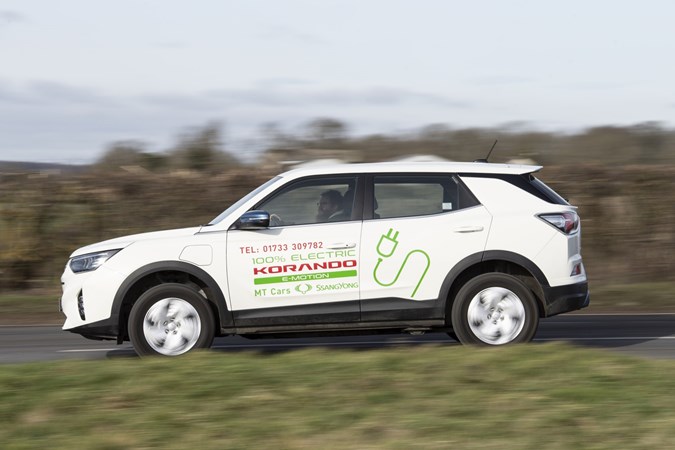
More useful is that the Korando appears to be able to actually return what the range counter says. We started out on a full charge with an indicated 205 miles, and after a 50-mile drive had dropped 52 miles of indicated range. Expect that to drop faster on the motorway, and last longer if you exclusively do town driving.
Charging from 0-100% on a 7kW home charger will take 11 hours. Public fast charging is quick but not exceptionally so – on a 50kW charger 20-80% will take 54 minutes, the same on a 100kW charger will take 33 minutes.
What models and trims are available?
The SsangYong Korando e-Motion comes in three trim levels. Basic ELX is still quite well-equipped with an 8.0-inch touchscreen featuring Apple CarPlay and Android Auto, dual-zone climate control, a reversing camera, digital instrument cluster, 17-inch alloy wheels and LED daytime running lights as well as the aforementioned safety equipment standard to all Korando e-Motions.
Move up to mid-spec Ventura – pictured here (stickers, dealer’s own) – and you gain faux-leather trim, heated front seats, a larger infotainment screen with its own navigation and rear parking sensors. Bafflingly, you need at least this trim level to benefit from a parcel shelf or a charging cable – though we suspect you might be able to pester your dealer to throw them in for free on an ELX.
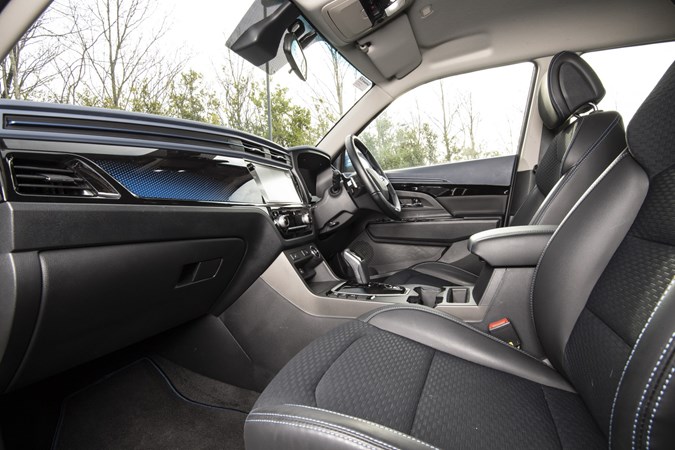
High-spec Ultimate cars top out at nearly £38,000 but do get full leather upholstery, electric adjustment for the heated and ventilated front seats, heated rear seats, a powered tailgate, all-round parking sensors, privacy glass and a wireless charging pad. This trim level also gets a heat pump for better efficiency in the winter.
What else should I know?
The Korando’s always been popular with caravanners, and the e-Motion may continue that as it’s a rare electric SUV that’s capable of towing. It’ll pull up to 1.5 tonnes braked, which constitutes a decent-sized caravan – though expect a serious reduction in your driving range if you do.
So is it a stand-out choice in an increasingly busy market sector? Read on for our verdict to find out whether we recommend the Korando e-Motion over its rivals.



